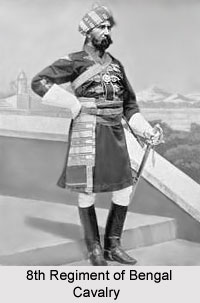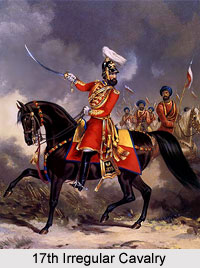 The 8th Regiment of Bengal Cavalry, also known as the 17th Irregular Cavalry or simply as 8th Cavalry, was one of the 40 Cavalry Regiments of the British Indian Army. The military unit was formed in the year 1846 by the British East India Company. The army regiment was a part of the Bengal Army under the British Indian Army. The Army of Bengal Province was the armed forces of Bengal Presidency and was amongst the 3 main Presidency Armies in British India. The British Presidency Armies belonged to the British East India Company until the Indian Rebellion, also known as Sepoy Mutiny of 1857. Later in the year 1904, the 3 separate presidency armies were united to form the unified British Indian Army. The unit also participated in the First World War and the Second World War. The unit also participated in the First World War and the Second World War.
The 8th Regiment of Bengal Cavalry, also known as the 17th Irregular Cavalry or simply as 8th Cavalry, was one of the 40 Cavalry Regiments of the British Indian Army. The military unit was formed in the year 1846 by the British East India Company. The army regiment was a part of the Bengal Army under the British Indian Army. The Army of Bengal Province was the armed forces of Bengal Presidency and was amongst the 3 main Presidency Armies in British India. The British Presidency Armies belonged to the British East India Company until the Indian Rebellion, also known as Sepoy Mutiny of 1857. Later in the year 1904, the 3 separate presidency armies were united to form the unified British Indian Army. The unit also participated in the First World War and the Second World War. The unit also participated in the First World War and the Second World War.
History of 8th Regiment of Bengal Cavalry
The 8th Lancers or the 8th Regiment of Bengal Cavalry was the final cavalry regiment of the British East India Company that was established before the Great Revolt of 1857. It was raised as the 17th Irregular Cavalry at Sultanpore by Captain W. H. Ryves in the year 1846. The battalion provided service in the conquest of Peshawar in the year 1857 and also served in the 2nd Afghan War. The regiment became the 8th Bengal Lancers in 1899 after it was issued with lances; and was later renamed as the 8th Lancers.
The 8th Bengal Lancers regiment was included as a part of the Jhansi Brigade at Mhow during the First World War. It was commanded by Major General Townsend and the army unit included the 8 Lancers, 2nd Royal Berkshire Regiment, 99th Decan Infantry, 116 Mahratta, 10th Jats, 107 Pioneers, 38th Central Indian Horse and 60 Company RGA. The regiment of the 8th Cavalry served on duties of on internal security British India during the First World War. Later in the year 1920, the army unit was stationed in Palestine. The 8th Regiment of Bengal Cavalry of the British Indian army provided military service in India and overseas as well. The regiment also participated in the conquests in Bhutan, Afghanistan and Mesopotamia.
Development of 8th Regiment of Bengal Cavalry
 The military unit of the 8th Regiment of Bengal Lancers was merged together with the 5th Cavalry regiment (also known as 5th Regiment of Bengal Cavalry and 7th Irregular Cavalry) in order to create the 3rd Cavalry regiment of the British Indian Army in the year 1922. The 3rd Cavalry later provided service on the North West Frontier. In the year 1941, the regiment of the 3rd Cavalry became a part of the 11th Indian Infantry Division and was posted in Malaya during the Second World War. The 3rd Cavalry was honoured with Battle Honours for Central Malaya and North Malaya. The 3rd Cavalry regiment was disbanded in the year 1946.
The military unit of the 8th Regiment of Bengal Lancers was merged together with the 5th Cavalry regiment (also known as 5th Regiment of Bengal Cavalry and 7th Irregular Cavalry) in order to create the 3rd Cavalry regiment of the British Indian Army in the year 1922. The 3rd Cavalry later provided service on the North West Frontier. In the year 1941, the regiment of the 3rd Cavalry became a part of the 11th Indian Infantry Division and was posted in Malaya during the Second World War. The 3rd Cavalry was honoured with Battle Honours for Central Malaya and North Malaya. The 3rd Cavalry regiment was disbanded in the year 1946.
Designations of 8th Regiment of Bengal Cavalry
The 8th Cavalry regiment was designated several times through the many restructuring and re-organisations in the British Indian Army. These are listed as follows-
* 17th Irregular Cavalry - 1846
* 18th Irregular Cavalry - 1847
* 8th Regiment of Bengal Cavalry - 1861
* 8th Regiment of Bengal Lancers - 1900
* 8th Bengal Lancers - 1901
* 8th Lancers - 1903
* 8th Cavalry - 1904
* 3rd Cavalry - 1922



















